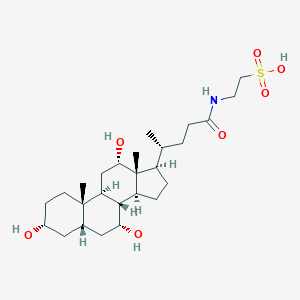Details of Metabolite
| Full List of Protein(s) Regulating This Metabolite | ||||||
|---|---|---|---|---|---|---|
| ATP-binding cassette transporter (ABCT) | ||||||
| ATP-binding cassette A8 (ABCA8) | Click to Show/Hide the Full List of Regulating Pair(s): 1 Pair(s) | |||||
| Detailed Information |
Protein Info
 click to show the details of this protein click to show the details of this protein
|
|||||
| Regulating Pair |
Experim Info
 click to show the details of experiment for validating this pair click to show the details of experiment for validating this pair
|
[1] | ||||
| Introduced Variation | Overexpression of ABCA8 | |||||
| Induced Change | Taurocholic acid concentration: decrease (FC = 0.63) | |||||
| Summary | Introduced Variation
|
|||||
| Disease Status | Healthy individual | |||||
| Details | It is reported that overexpression of ABCA8 leads to the decrease of taurocholic acid levels compared with control group. | |||||
| Fatty acid transporter (FAT) | ||||||
| Solute carrier family 27 member 5 (SLC27A5) | Click to Show/Hide the Full List of Regulating Pair(s): 1 Pair(s) | |||||
| Detailed Information |
Protein Info
 click to show the details of this protein click to show the details of this protein
|
|||||
| Regulating Pair |
Experim Info
 click to show the details of experiment for validating this pair click to show the details of experiment for validating this pair
|
[2] | ||||
| Introduced Variation | Knockdown (shRNA) of Slc27a5 | |||||
| Induced Change | Taurocholic acid concentration: decrease | |||||
| Summary | Introduced Variation
|
|||||
| Disease Status | Healthy individual | |||||
| Details | It is reported that knockdown of Slc27a5 leads to the decrease of taurocholic acid levels compared with control group. | |||||
| Nuclear hormone receptor (NHR) | ||||||
| PPAR-alpha (PPARA) | Click to Show/Hide the Full List of Regulating Pair(s): 1 Pair(s) | |||||
| Detailed Information |
Protein Info
 click to show the details of this protein click to show the details of this protein
|
|||||
| Regulating Pair |
Experim Info
 click to show the details of experiment for validating this pair click to show the details of experiment for validating this pair
|
[3] | ||||
| Introduced Variation | Knockout of Ppara | |||||
| Induced Change | Taurocholic acid concentration: increase | |||||
| Summary | Introduced Variation
|
|||||
| Disease Status | Healthy individual | |||||
| Details | It is reported that knockout of Ppara leads to the increase of taurocholic acid levels compared with control group. | |||||
| Transferases (EC 2) | ||||||
| Pyrophosphate geranylgeranyl synthase (GGPS1) | Click to Show/Hide the Full List of Regulating Pair(s): 1 Pair(s) | |||||
| Detailed Information |
Protein Info
 click to show the details of this protein click to show the details of this protein
|
|||||
| Regulating Pair |
Experim Info
 click to show the details of experiment for validating this pair click to show the details of experiment for validating this pair
|
[4] | ||||
| Introduced Variation | Knockout of Ggps1 | |||||
| Induced Change | Taurocholic acid concentration: decrease | |||||
| Summary | Introduced Variation
|
|||||
| Disease Status | Metabolic liver disease [ICD-11: 5C90] | |||||
| Details | It is reported that knockout of Ggps1 leads to the decrease of taurocholic acid levels compared with control group. | |||||
If you find any error in data or bug in web service, please kindly report it to Dr. Zhang and Dr. Mou.

